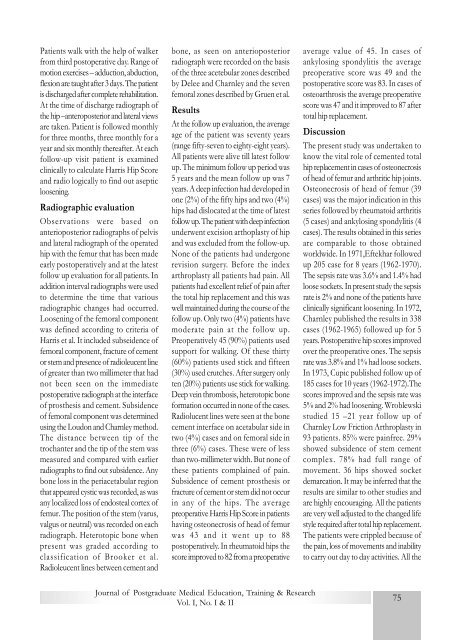Journal 1pages FINAL 34- - National Board Of Examination
Journal 1pages FINAL 34- - National Board Of Examination
Journal 1pages FINAL 34- - National Board Of Examination
You also want an ePaper? Increase the reach of your titles
YUMPU automatically turns print PDFs into web optimized ePapers that Google loves.
Patients walk with the help of walkerfrom third postoperative day. Range ofmotion exercises – adduction, abduction,flexion are taught after 3 days. The patientis discharged after complete rehabilitation.At the time of discharge radiograph ofthe hip –anteroposterior and lateral viewsare taken. Patient is followed monthlyfor three months, three monthly for ayear and six monthly thereafter. At eachfollow-up visit patient is examinedclinically to calculate Harris Hip Scoreand radio logically to find out asepticloosening.Radiographic evaluationObservations were based onanterioposterior radiographs of pelvisand lateral radiograph of the operatedhip with the femur that has been madeearly postoperatively and at the latestfollow up evaluation for all patients. Inaddition interval radiographs were usedto determine the time that variousradiographic changes had occurred.Loosening of the femoral componentwas defined according to criteria ofHarris et al. It included subseidence offemoral component, fracture of cementor stem and presence of radioleucent lineof greater than two millimeter that hadnot been seen on the immediatepostoperative radiograph at the interfaceof prosthesis and cement. Subsidenceof femoral component was determinedusing the Loudon and Charnley method.The distance between tip of thetrochanter and the tip of the stem wasmeasured and compared with earlierradiographs to find out subsidence. Anybone loss in the periacetabular regionthat appeared cystic was recorded, as wasany localized loss of endosteal cortex offemur. The position of the stem (varus,valgus or neutral) was recorded on eachradiograph. Heterotopic bone whenpresent was graded according toclassification of Brooker et al.Radioleucent lines between cement andbone, as seen on anterioposteriorradiograph were recorded on the basisof the three acetebular zones describedby Delee and Charnley and the sevenfemoral zones described by Gruen et al.ResultsAt the follow up evaluation, the averageage of the patient was seventy years(range fifty-seven to eighty-eight years).All patients were alive till latest followup. The minimum follow up period was5 years and the mean follow up was 7years. A deep infection had developed inone (2%) of the fifty hips and two (4%)hips had dislocated at the time of latestfollow up. The patient with deep infectionunderwent excision arthoplasty of hipand was excluded from the follow-up.None of the patients had undergonerevision surgery. Before the indexarthroplasty all patients had pain. Allpatients had excellent relief of pain afterthe total hip replacement and this waswell maintained during the course of thefollow up. Only two (4%) patients havemoderate pain at the follow up.Preoperatively 45 (90%) patients usedsupport for walking. <strong>Of</strong> these thirty(60%) patients used stick and fifteen(30%) used crutches. After surgery onlyten (20%) patients use stick for walking.Deep vein thrombosis, heterotopic boneformation occurred in none of the cases.Radiolucent lines were seen at the bonecement interface on acetabular side intwo (4%) cases and on femoral side inthree (6%) cases. These were of lessthan two-millimeter width. But none ofthese patients complained of pain.Subsidence of cement prosthesis orfracture of cement or stem did not occurin any of the hips. The averagepreoperative Harris Hip Score in patientshaving osteonecrosis of head of femurwas 43 and it went up to 88postoperatively. In rheumatoid hips thescore improved to 82 from a preoperativeaverage value of 45. In cases ofankylosing spondylitis the averagepreoperative score was 49 and thepostoperative score was 83. In cases ofosteoarthrosis the average preoperativescore was 47 and it improved to 87 aftertotal hip replacement.DiscussionThe present study was undertaken toknow the vital role of cemented totalhip replacement in cases of osteonecrosisof head of femur and arthritic hip joints.Osteonecrosis of head of femur (39cases) was the major indication in thisseries followed by rheumatoid arthritis(5 cases) and ankylosing spondylitis (4cases). The results obtained in this seriesare comparable to those obtainedworldwide. In 1971,Eftekhar followedup 205 case for 8 years (1962-1970).The sepsis rate was 3.6% and 1.4% hadloose sockets. In present study the sepsisrate is 2% and none of the patients haveclinically significant loosening. In 1972,Charnley published the results in 338cases (1962-1965) followed up for 5years. Postoperative hip scores improvedover the preoperative ones. The sepsisrate was 3.8% and 1% had loose sockets.In 1973, Cupic published follow up of185 cases for 10 years (1962-1972).Thescores improved and the sepsis rate was5% and 2% had loosening. Wroblewskistudied 15 –21 year follow up ofCharnley Low Friction Arthroplasty in93 patients. 85% were painfree. 29%showed subsidence of stem cementcomplex. 78% had full range ofmovement. 36 hips showed socketdemarcation. It may be inferred that theresults are similar to other studies andare highly encouraging. All the patientsare very well adjusted to the changed lifestyle required after total hip replacement.The patients were crippled because ofthe pain, loss of movements and inabilityto carry out day to day activities. All the<strong>Journal</strong> of Postgraduate Medical Education, Training & ResearchVol. I, No. I & II75
















